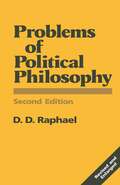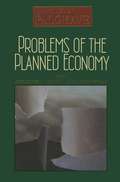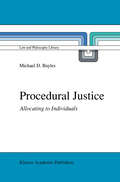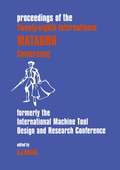- Table View
- List View
Probabilistic Methods in Quantum Field Theory and Quantum Gravity (Nato Science Series B: #224)
by Poul Henrik Damgaard H. Hüffel A. RosenblumFrom August 21 through August 27, 1989 the Nato Advanced Research Workshop Probabilistic Methods in Quantum Field Theory and Quantum Gravity" was held at l'Institut d'Etudes Scientifiques, Cargese, France. This publication is the Proceedings of this workshop. The purpose of the workshop was to bring together a group of scientists who have been at the forefront of the development of probabilistic methods in Quantum Field Theory and Quantum Gravity. The original thought was to put emphasis on the introduction of stochastic processes in the understanding of Euclidean Quantum Field Theory, with also some discussion of recent progress in the field of stochastic numerical methods. During the final preparation of the meeting we broadened the scope to include all those Euclidean Quantum Field Theory descriptions that make direct reference to concepts from probability theory and statistical mechanics. Several of the main contributions centered around a more rigorous discussion of stochastic processes for the formulation of Euclidean Quantum Field Theory. These rather stringent mathematical approaches were contrasted with the more heuristic stochastic quantization scheme developed in 1981 by Parisi and Wu: Stochastic quan tization, its intrinsic BRST -structure and stochastic regularization appeared in many disguises and in connection with several different problems throughout the workshop.
Probability for Applications (Springer Texts in Statistics)
by Paul E. PfeifferObjecti'ves. As the title suggests, this book provides an introduction to probability designed to prepare the reader for intelligent and resourceful applications in a variety of fields. Its goal is to provide a careful exposition of those concepts, interpretations, and analytical techniques needed for the study of such topics as statistics, introductory random processes, statis tical communications and control, operations research, or various topics in the behavioral and social sciences. Also, the treatment should provide a background for more advanced study of mathematical probability or math ematical statistics. The level of preparation assumed is indicated by the fact that the book grew out of a first course in probability, taken at the junior or senior level by students in a variety of fields-mathematical sciences, engineer ing, physics, statistics, operations research, computer science, economics, and various other areas of the social and behavioral sciences. Students are expected to have a working knowledge of single-variable calculus, including some acquaintance with power series. Generally, they are expected to have the experience and mathematical maturity to enable them to learn new concepts and to follow and to carry out sound mathematical arguments. While some experience with multiple integrals is helpful, the essential ideas can be introduced or reviewed rather quickly at points where needed.
Probability in Banach Spaces 6: Proceedings of the Sixth International Conference, Sandbjerg, Denmark 1986 (Progress in Probability #20)
by HaagerupThis volume contains a selection of papers by the participants of the 6. International Conference on Probability in Banach Spaces, Sand bjerg, Denmark, June 16-D1, 1986. The conference was attended by 45 participants from several countries. One thing makes this conference completely different from the previous five ones, namely that it was ar ranged jointly in Probability in Banach spaces and Banach space theory with almost equal representation of scientists in the two fields. Though these fields are closely related it seems that direct collaboration between researchers in the two groups has been seldom. It is our feeling that the conference, where the participants were together for five days taking part in lectures and intense discussions of mutual problems, has contributed to a better understanding and closer collaboration in the two fields. The papers in the present volume do not cover all the material pre sented in the lectures; several results covered have been published else where. The sponsors of the conference are: The Carlsberg Foundation, The Danish Natural Science Research Council, The Danish Department of Education, The Department of Mathematics, Odense University, The Department of Mathematics, Aarhus University, The Knudsen Foundation, Odense, Odense University, The Research Foundation of Aarhus University, The Thborg Foundation. The participants and the organizers would like to thank these institu tions for their support. The Organizers. Contents A. de Acosta and M. Ledoux, On the identification of the limits in the law of the iterated logarithm in Banach spaces. . . . .
Probability in Banach Spaces 7: Proceedings of the Seventh International Conference (Progress in Probability #21)
by Eberlein Külbs MarcusThe first international conference on Probability in Banach Spaces was held at Oberwolfach, West Germany, in 1975. It brought together European researchers who, under the inspiration of the Schwartz Seminar in Paris, were using probabi listic methods in the study of the geometry of Banach spaces, a rather small number of probabilists who were already studying classical limit laws on Banach spaces, and a larger number of probabilists, specialists in various aspects of the study of Gaussian processes, whose results and techniques were of interest to the members of the first two groups. This first conference was very fruitful. It fos tered a continuing relationship among 50 to 75 probabilists and analysts working on probability on infinite-dimensional spaces, the geometry of Banach spaces, and the use of random methods in harmonic analysis. Six more international conferences were held since the 1975 meeting. Two of the meetings were held at Tufts University, one at S¢nderborg, Denmark, and the others at Oberwolfach. This volume contains a selection of papers by the partici pants of the Seventh International Conference held at Oberwolfach, West Ger many, June 26-July 2, 1988. This exciting and provocative conference was at tended by more than 50 mathematicians from many countries. These papers demonstrate the range of interests of the conference participants. In addition to the ongoing study of classical and modern limit theorems in Banach spaces, a branching out has occurred among the members of this group.
Problematic Shores: The Literature Of Islands
by Diana LoxleyThe desert island has been one of the powerful and insistent motifs in British literature and this book deals with the reproduction of the desert island myth during the era of high imperialism in 19th century Britain. The book examines a series of works from Defoe to Stevenson.
Problems in Mathematical Analysis (Chapman And Hall/crc Pure And Applied Mathematics Ser.)
by BilerChapter 1 poses 134 problems concerning real and complex numbers, chapter 2 poses 123 problems concerning sequences, and so it goes, until in chapter 9 one encounters 201 problems concerning functional analysis. The remainder of the book is given over to the presentation of hints, answers or referen
Problems in Mathematical Analysis (Chapman And Hall/crc Pure And Applied Mathematics Ser.)
by BilerChapter 1 poses 134 problems concerning real and complex numbers, chapter 2 poses 123 problems concerning sequences, and so it goes, until in chapter 9 one encounters 201 problems concerning functional analysis. The remainder of the book is given over to the presentation of hints, answers or referen
Problems in Movement Control (ISSN #Volume 74)
by G. ReidDifficulties in motor behavior are commonly associated with a variety of disabilities. Early research efforts focused on descriptions of specific groups of people or on evaluations of intervention programs. Only recently have investigators begun to explore questions from a variety of theoretical positions in an attempt to build a more fundamental understanding of the disabled person. The present volume represents views of major methodological issues, current research fronts and selected applied concerns from the perspective of the disabled performer. Authors write from a number of theoretical viewpoints and sketch future research directions in these chapters.
The Problems of Jurisprudence
by Richard A. PosnerIn this book, one of our country’s most distinguished scholar-judges shares with us his vision of the law. For the past two thousand years, the philosophy of law has been dominated by two rival doctrines. One contends that law is more than politics and yields, in the hands of skillful judges, correct answers to even the most difficult legal questions; the other contends that law is politics through and through and that judges wield essentially arbitrary powers. Rejecting these doctrines as too metaphysical in the first instance and too nihilistic in the second, Richard Posner argues for a pragmatic jurisprudence, one that eschews formalism in favor of the factual and the empirical. Laws, he argues, are not abstract, sacred entities, but socially determined goads for shaping behavior to conform with society’s values. Examining how judges go about making difficult decisions, Posner argues that they cannot rely on either logic or science, but must fall back on a grab bag of informal methods of reasoning that owe less than one might think to legal training and experience. Indeed, he reminds us, the greatest figures in American law have transcended the traditional conceptions of the lawyer’s craft. Robert Jackson did not attend law school and Benjamin Cardozo left before getting a degree. Holmes was neither the most successful of lawyers nor the most lawyerly of judges. Citing these examples, Posner makes a plea for a law that frees itself from excessive insularity and takes all knowledge, practical and theoretical, as grist for its mill. The pragmatism that Posner espouses implies looking at problems concretely, experimentally, without illusions, with an emphasis on keeping diverse paths of inquiry open, and, above all, with the insistence that social thought and action be evaluated as instruments to desired human goals rather than as ends in themselves. In making his arguments, he discusses notable figures in jurisprudence from Antigone to Ronald Dworkin as well as recent movements ranging from law and economics to civic republicanism, and feminism to libertarianism. All are subjected to Posner’s stringent analysis in a fresh and candid examination of some of the deepest problems presented by the enterprise of law.
Problems of Political Philosophy
by D. D. RaphaelThis book introduces the student to active philosophical thinking about political ideas, offering a more stimulating approach to the subject than traditional chronological surveys. The first edition was hailed by The Times Literary Supplement as 'the best introduction to political philosophy for a long time'. This thoroughly revised second edition brings its coverage up-to-date for the 1990s, with material reorganised to be fully accessible for the beginner.
Problems of the Planned Economy (The New Palgrave)
by John Eatwell Murray Milgate Peter NewmanThis is an excerpt from the 4-volume dictionary of economics, a reference book which aims to define the subject of economics today. 1300 subject entries in the complete work cover the broad themes of economic theory. This extract concentrates on problems encountered in a planned economy.
Procedural Justice: Allocating to Individuals (Law and Philosophy Library #10)
by M.E. BaylesDuring the last half of the twentieth century, legal philosophy (or legal theory or jurisprudence) has grown significantly. It is no longer the domain of a few isolated scholars in law and philosophy. Hundreds of scholars from diverse fields attend international meetings on the subject. In some universities, large lecture courses of five hundred students or more study it. The primary aim of the Law and Philosophy Library is to present some of the best original work on legal philosophy from both the Anglo-American and European traditions. Not only does it help make some of the best work available to an international audience, but it also encourages increased awareness of, and interaction between, the two major traditions. The primary focus is on fu- length scholary monographs, although some edited volumes of original papers are also included. The Library editors are assisted by an Editorial Advisory Board of internationally renowned scholars. Legal philosophy should not be considered a narrowly circumscribed field. Insights into law and legal institutions can come from diverse disciplines on a wide range of topics. Among the relevant disciplines or perspectives contribut ing to legal philosophy, besides law and philosophy, are anthropology, economics, political science, and sociology. Among the topics included in legal philosophy are theories of law; the concepts of law and legal institutions; legal reasoning and adjudication; epistemological issues of evidence and pro cedure; law and justice, economics, politics, or morality; legal ethics; and theories oflegal fields such as criminal law, contracts, and property.
Procedures in Gastrointestinal Radiology
by Julian Dobranowski David A. Stringer Sat Somers Giles W. StevensonDr. Dobranowski and his associates are to be highly commended for this excellent manual. I am not aware of a similar text covering the subject. Although all of us perform gastrointestinal studies in a differ ent manner, this text provides an excellent overview. The reader will discover that the text is especially well written and focuses on the important issues relating to GI contrast studies. Because Dr. Steven son's group performs endoscopic procedures, they are included in the manual. These authors are recognized scholars and leaders in gastrointesti nal radiology. Thus, it is easy to understand why the manual is so well done. I am particularly impressed with the emphasis placed on the patient-radiologist relationship before, during, and after completion of a study. All of us who teach gastrointestinal radiology are concerned about the decline in the number of gastrointestinal contrast studies. We are not sure how we can continue to teach our residents the proper tech niques and maintain high-quality teaching programs in gastrointesti nal radiology. A manual of this type is thus timely and appropriate. The manual will be a valuable addition to the library of all radiologists. It will be particularly useful for residents who are learning how to per form GI contrast studies.
Proceedings of the Tenth Power Systems Computation Conference
by Graz AustriaProceedings of the Tenth Power Systems Computation Conference
Proceedings of the Third European Conference on Mathematics in Industry: August 28–31, 1988 Glasgow (European Consortium for Mathematics in Industry #5)
by J. Manley S. McKee D. R. OwensProceedings of the Twenty-eighth International: Matador Conference
The collected papers of the 28th MATADOR Conference held in April 1990 in Manchester. In contrast to previous conferences the subject matter was divided up into 4 sessions, each running as an individual conference, with its own chair.
Proceedings of the Winter, 1990, International Joint Conference on Neural Networks
by Maureen CaudillThis two volume set provides the complete proceedings of the 1990 International Joint Conference on Neural Networks held in Washington, D.C. Complete with subject, author, and title indices, it provides an invaluable reference to the current state-of-the-art in neural networks. Included in this volume are the latest research results, applications, and products from over 2,000 researchers and application developers from around the world. Ideal as a reference for researchers and practitioners of neuroscience, the two volumes are divided into eight sections: * Neural and Cognitive Sciences * Pattern Recognition and Analysis of Network Dynamics * Learning Theory * Plenary Lecture by Bernard Widrow * Special Lectures on Self-Organizing Neural Architectures * Application Systems and Network Implementations * Robotics, Speech, Signal Processing, and Vision * Expert Systems and Other Real-World Applications
Proceedings of the Winter, 1990, International Joint Conference on Neural Networks
by International Neural Network Society and the Institute of Electrical and Electronics Engineers, Inc.This two volume set provides the complete proceedings of the 1990 International Joint Conference on Neural Networks held in Washington, D.C. Complete with subject, author, and title indices, it provides an invaluable reference to the current state-of-the-art in neural networks. Included in this volume are the latest research results, applications, and products from over 2,000 researchers and application developers from around the world. Ideal as a reference for researchers and practitioners of neuroscience, the two volumes are divided into eight sections: * Neural and Cognitive Sciences * Pattern Recognition and Analysis of Network Dynamics * Learning Theory * Plenary Lecture by Bernard Widrow * Special Lectures on Self-Organizing Neural Architectures * Application Systems and Network Implementations * Robotics, Speech, Signal Processing, and Vision * Expert Systems and Other Real-World Applications
Processes of Vegetation Change
by C.J. BurrowsThis book is about ideas on the nature and causes of temporal change in the species composition of vegetation. In particular it examines the diverse processes of inter action of plants with their environment, and with one another, through which the species composition of vegetation becomes established. The first chapter considers the general nature of vegetation and the ways in which vegetation change is perceived by ecologists. Chapters 2 and 3 provide essential background about the relationships between plants and their abiotic and biotic environment. Anyone who is familiar with the fundamentals of plant ecology may prefer to pass over Chapters 2 and 3 which, of necessity, cover their subject matter very briefly. Sequences of development of vegetation on new volcanic rocks, sand dunes and glacial deposits, respectively, are outlined in Chapters 4, 5 and 6. Chapter 7 is about the patterns of vegetation change which occur in severe habitats around the world, and Chapter 8 discusses wetlands. Chapter 9 discusses the diverse responses of temperate forests to a variety of disturbing influences, and Chapter 10 deals with change in the species-rich forests of the Tropics. Chapter 11 treats, in detail, the empirical and inferential data on the biological processes occurring during vegetation change sequences. Chapter 12 considers the plant community phenomena which are implicated in the development of theory about vegetation change. The final chapter, Chapter 13, draws the diverse themes together into a unified theoretical structure by which the vegetation change phenomena may be understood.
Product Design and Testing of Polymeric Materials
by Louise FerranteProduct Design and Testing of Polymeric Materials integrates polymer science principles with detailed experimental programs—helping engineers create optimal products. Thoroughly investigating both physical and processing properties of polymeric substances, this valuable guide presents the philosophy of product development management … includes test methods for base property and end-use performance … pairs viscometric and small-scale testing with molecular properties for processing advantages … examines quality control from the laboratory to the marketplace … applies the mechanics of experimental design to product optimization problems … covers the mathematics needed for proper regression of experimental data … and much more. Product Design and Testing of Polymeric Materials is a complete reference— defining numerous plastics and engineering terms and supplying important data on elastomers and plastics—and is an essential resource for polymer, plastics, and chemical engineers and scientists, materials scientists, and graduate-level students in these disciplines.
Product Design and Testing of Polymeric Materials
by Louise FerranteProduct Design and Testing of Polymeric Materials integrates polymer science principles with detailed experimental programs—helping engineers create optimal products. Thoroughly investigating both physical and processing properties of polymeric substances, this valuable guide presents the philosophy of product development management … includes test methods for base property and end-use performance … pairs viscometric and small-scale testing with molecular properties for processing advantages … examines quality control from the laboratory to the marketplace … applies the mechanics of experimental design to product optimization problems … covers the mathematics needed for proper regression of experimental data … and much more. Product Design and Testing of Polymeric Materials is a complete reference— defining numerous plastics and engineering terms and supplying important data on elastomers and plastics—and is an essential resource for polymer, plastics, and chemical engineers and scientists, materials scientists, and graduate-level students in these disciplines.
The Production of Commodities: Introduction to Sraffa (Radical Economics)
by John E. WoodsThe purpose of this book is to provide an elementary account of Sraffa's Production of Commodities by means of Commodities. Operating with a two-sector model in order to minimise the mathematical demands on the reader, the author is nonetheless able to analyse all the essential questions arising from Sraffa's book-prices of production, choice of technique, fixed capital, land and joint production - as well as discuss micro- and macro-economic implications of this theory.
Production Wine Analysis
by Bruce W. ZoeckleinThis text is designed to acquaint the reader with the commonly used procedures of juice and wine analysis as they are generally practiced in the industry, and as they are taught in the Department of Enology at California State University, Fresno. It is assumed that the reader has a basic preparation in the fields of chemistry and microbiology. In developing material for this text, the authors have emphasized analyses as they would be carried out in a production laboratory. Realizing that different laboratories have different analytical capabilities, personnel as well as equip ment, we have in many instances provided several different approaches to the same analysis. Throughout this book we have attempted to give special attention to practical considerations and the importance of these analyses in the total spectrum of winery operations. We hope the book's format will satisfy the inter ests oflaboratory personnel as well as winemakers. The process of making wine involves a series of concerns for the winemaker and staff of a winery. The first concerns are viticultural. Upon arrival of the fruit, its quality is assessed, grapes are processed and fermentation is begun. Almost immediately, and in many instances simultaneously, chemical and microbiological stability of the young and/or aging wine become important. Finally, problems do occur on occasion, and a number of what may be consid ered remedial techniques can be employed to produce an acceptable product.
Profound Retardation and Multiple Impairment: Volume 3: Medical and physical care and management
by JUDY SEBBA JAMES HOGGProgramming in the 1990s: An Introduction to the Calculation of Programs (Monographs in Computer Science)
by Edward CohenProgramming is a fascinating and challenging subject. Unfortunately, it is rarely presented as such. Most often it is taught by "induction": features of some famous programming languages are given operational meaning (e.g. a loop "goes round and round"), a number of examples are shown, and by induction, we are asked to develop other programs, often radically different from the ones we've seen. Basically we are taught to guess our programs, and then to patch up our guesses. Our errors are given the cute name of "bugs". Fixing them becomes puzzle-solving, as does finding tricks that exploit or avoid poorly designed features of the programming language. The entire process is time-consuming and expensive. And even so, we are never quite sure if our programs really work in all cases. When approached in this way, programming is indeed a dull activity. There is, however, another approach to programming, an approach in which programs can be developed reliably, with attention to the real issues. It is a practical approach based on methodically developing programs from their specifications. Besides being practical, it is exciting. Many programs can be developed with relative ease. Problems which once were difficult can now be solved by beginners. Elegant solutions bring great satisfaction. This is our subject. We are interested in making programming an exciting topic!





















